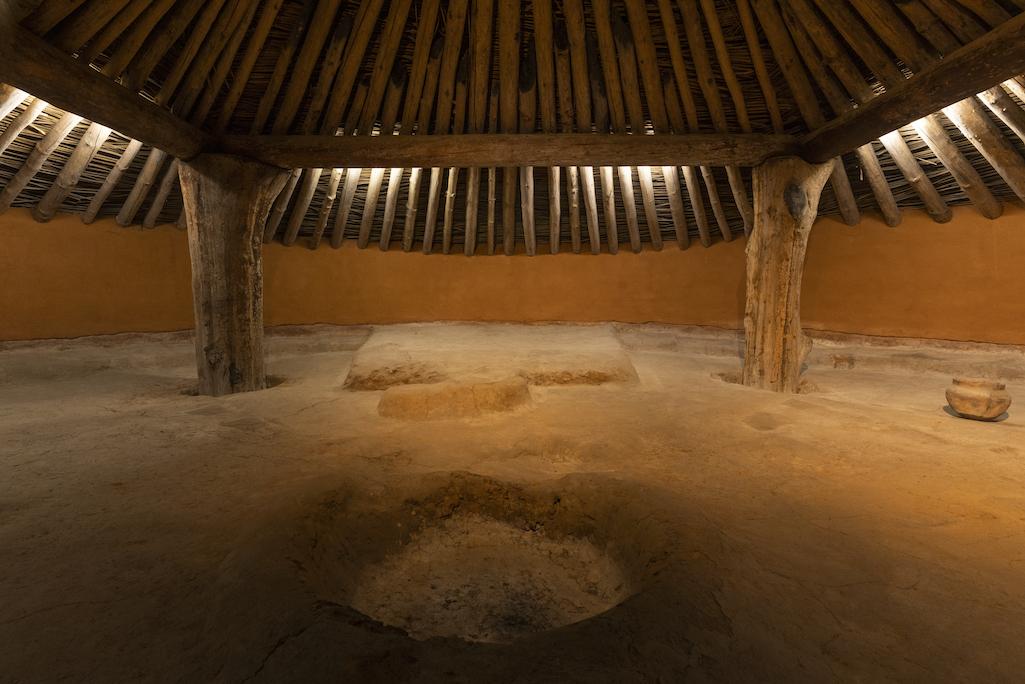
The Earth Lodge, dated to 1015 AD, was built by the Mississippian culture and later restored from archaeological evidence and is part of Ocmulgee National Historical Park/Open Space Institute, Mac Stone.
There are few outward signs that Ocmulgee Mounds National Historical Park is tucked into the middle of Macon, Georgia, surrounded by residential and commercial development. My family and I nearly drove past the entrance as our heads moved from the phone directions to the road and back again. But as soon as we followed the signature national park signs, it felt like a curtain of greenery wrapped itself around our car. We could hear sounds of the city, but all we saw were shades of emerald.
Ocmulgee Mounds National Historical Park was established as a national monument first in the 1930s to protect the archaeological artifacts and mounds established here, sacred and political sites once home to an important human settlement more than 1,000 years ago. A window into a long-ago world, the park also provides habitat for songbirds and raptors, resting during migration or making their summer breeding grounds here.
I felt a familiar thrum of excitement as we pulled up to the visitor center. We visited in this summer, and I hadn’t seen a new-to-me national park site since 2019, a kid and a pandemic reducing my usual travel radius. In fact, in those intervening two-and-a-half years I had only set foot in one national park – Gulf Islands National Seashore – and was thrilled to finally explore a new site. Even the gathering stormclouds overhead couldn’t darken my mood.
My husband, toddler, and I set out across a small footbridge towards the park’s main trail, weaving through trees, meadow, and ceremonial mounds. We ducked our heads into the relative coolness of the Earth Lodge, 42 feet in diameter and dating back to 1015. Despite the noises from outside, everything felt still and serene within the mound. Everything except for my toddler, who thought it was good fun to hurl himself up and down the tunnel connecting the outside with the inner chamber. Needless to say we quickly hustled him out.
A Mississippi Kite perched in a nearby branch, watching our progress as we wound our way to the railroad tracks that cut the park in two. Birds flew and flit every which way, from Great Egrets soaring overhead to Eastern Wood-Peewees in a nearby stand of trees to the unique calls of a Yellow-billed Cuckoo.
The train itself sounded much more jarring, barreling towards us. From a raised bridge we watched the black behemoth rumble beneath our feet – which I actually do not recommend because it was not only loud but hot. The train in fact is a moving reminder that we need to advocate for the continued protection of our parks, even after they have been officially protected. The first train construction literally destroyed part of the Lesser Temple Mound in 1843, and now fractures the ceremonial sites.
Across the tracks one of the largest ceremonial mounds rose in the distance: the Great Temple mound, rising 55 feet into the air and built between 900 and 1000 AD. From our vantage point we spotted another family climbing to the top, but we opted to just look, as the clouds now boasted both thunder and lightning. Eventually, a pounding rain chased us back to the visitor center.
Luckily for us, the center houses a lovely little museum, explaining the history of the site and tracing the people who once lived here to the indigenous communities now living farther west after forced relocations. If I redid the visit, I would have stopped by the museum first, to give the mounds and Earth Lodge additional context.
As we trundled back to the car, I wished we had had more time at Ocmulgee. I noticed one or two locals jogging and walking their dogs here, and now know what amazing natural and historical resource they have right in their own backyard! I highly recommend devoting at least three hours to both exploration and quiet reflection at this national historical site, and hope I can return.
Traveler postscript: Early this year a land transaction added more than 900 acres to Ocmulgee. You can read the story here.



Add comment